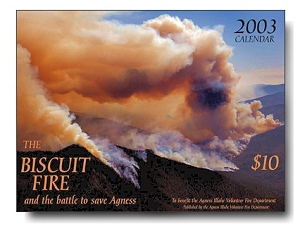
|
|
| www.wildfirenews.com | Archived 02-27-2003 |
FIRE BILL CUTS FUNDS FOR RESEARCH AND FOREST RESTORATIONFEBRUARY 27 -- MISSOULA, MT: The U.S. Forest Service will not be reimbursed for nearly $300 million of the $1.2 billion the agency spent fighting wildfires last summer, leaving some forest restoration and research programs without full funding. The Missoulian reported today that another billion-dollar fire season would mean even more work could be unfunded. The federal government's just-signed fiscal year 2003 appropriations bill reimbursed the Forest Service for $636 million of the $919 million "borrowed" from national forests and research labs nationwide to pay last summer's suppression costs. The season last year was so expensive that the Forest Service's $275 million firefighting budget was depleted by the end of June. When Congress refused to approve emergency supplemental funding, the Forest Service froze all non-fire budgets and raided them for fire funds. The Region 1 forests of Montana and northern Idaho lost about $80 million, including $25 million intended for restoration and replanting of forests burned two summers earlier on the Bitterroot National Forest. "We've had the authority to transfer funds to pay for wildfire suppression for a long, long time," said regional budget director Mike Paterni. "But this is the first time we've had to use it, at least in my memory." In the past, Congress has either approved emergency midseason funds for firefighting or has quickly restored any raided accounts at the end of the year. This time, congressional leaders warned the Forest Service not to expect 100 percent reimbursement. "This really makes it difficult to be a prudent manager - if you're always trying to second-guess what's going to happen and modifying your program based on how you read the tea leaves," said Kevin Ryan, fire effects project leader at the Fire Sciences Lab in Missoula. "It makes it extremely difficult to make good, sound decisions and to see those decisions through." The Bitterroot National Forest took a sizable hit because it had $25 million in National Fire Plan money in the bank when the call came for help, according to deputy forest supervisor Spike Thompson. That money was intended for the rehabilitation of forests burned during the 2000 wildfire season. "We are still hopeful that we will get enough funds restored that we'll be on schedule with this year's work," said Thompson. "We are really committed to this work, but we've always known it would take three to five years, and probably 10 years for the reforestation." The work on the Bitterroot includes watershed rehabilitation, road repair, and reforestation work on the 300,000 acres burned during the summer of 2000. Less than 2 percent of the watershed work included in the forest's burned area recovery plan has been completed. SAN BERNARDINO EYES FIRESTORM POSSIBILITYFEBRUARY 25 -- SAN BERNARDINO, CA: It may be an inferno that's hotter, faster, and more dangerous than anything most firefighters have seen. Thousands of dead and dying trees spread across the San Bernardino Mountains stand like giant gasoline cans awaiting a spark, and all that dry timber has fire officials discussing strategy. "We've never been experienced with this amount of dead vegetation," Capt. Lyle Drenth with CDF told the San Bernardino County Sun. More than 150,000 acres on the San Bernardino National Forest have experienced major tree die-offs, due to a four-year drought and an infestation of bark beetles. "If a crown fire started running," said Drenth, "it wouldn't matter if you had one fire engine or one hundred, because you can't get in front of it. If we burn an engine or get people hurt, we won't be effective." Officials compare the situation to fireplace fuels. Logs in a fireplace require a lot of heat before they ignite, because of the moisture inside the wood. Right now, the dead trees on the San Bernardino would burn like open newspaper tossed into the flames, flaring up hot and fast. Firefighters saw similar behavior at wildfires last summer; CDF Assistant Chief Tim Sappok said flamelengths were 25 to 50 percent more than normal. "It's off the scale of what we've seen before," said Sappok. "We could make some saves in places if we recognize what's going on. If we attack it the way we're used to, we're going to lose people." In Lake Arrowhead, Crestline, and other mountain communities, homes are nestled among thick stands of dead trees. Firefighters, who normally would focus on saving property, may have to turn their attention to the forest. "We may have to let one house go to save a hundred," said Chief Bill Bagnell of the Crest Forest Fire Protection District. "That'll be hard for firefighters." Drenth said any home on the side of a slope or at the top of a ridge may be indefensible. Under normal circumstances, firefighters would aggressively try to save homes in those locations, but a fire in current conditions would be moving too fast and burning too hot to risk firefighters' lives. During a recent tour of areas around Lake Arrowhead hardest hit by the drought and bark beetles, county Fire Marshal Peter Brierty pointed to narrow, steep, tree-choked roads. "If you're a battalion chief, do you send your people down there?" asked Brierty. CDF crews are felling dead trees alongside main roads to help ensure a safe evacuation and create wider firebreaks; the Forest Service is cutting a 600-foot shaded firebreak along the north part of Lake Arrowhead. MARINE CORPS BILLED $10 MILLION FOR FIRE WHERE WASS, LEBARE, AND DAVIS CRASHEDFEBRUARY 22 -- CARSON CITY, NV: The U.S. Marine Corps has been asked to pay $10 million to cover suppression costs on the 22,750-acre Cannon Fire near Yosemite that took the lives of three aerial firefighters last June. The fire was ignited in an area where Marine mountain warfare trainees had set dozens of practice campfires, but the Forest Service's report on its cause hasn't been released. The Marines haven't released details of their report on the blaze, either, according to an Associated Press report, and the U.S. Department of Justice is reviewing the Forest Service's report. The Forest Service confirmed Wednesday that the cost estimate of the fire, which burned along the California-Nevada state line, went to the Marines, who run a mountain warfare training base in the area. First Lt. Daniel Rawson said the Marine Corps was working to resolve the issue in a timely and equitable manner, and negotiators are focused on interagency agreements between the Marines and the Forest Service. The USMC Mountain Warfare Training Center was established in 1951 as a Cold Weather Battalion to provide cold weather training for replacement personnel bound for Korea. MCMWTC is located on California Highway 108 at Pickel Meadow, 21 miles northwest of Bridgeport, California and 100 miles south of Reno, Nevada. The center occupies 46,000 acres of Toiyabe National Forest, and an agreement between the Forest Service and the Marine Corps permits the use of the area to train Marines in mountain and cold weather operations. The Forest Service says the agreements require the Department of Defense to pay it for any costs directly attributable to military training in the area -- subject to available funds. Four days after the fire began, a C-130A airtanker assigned to the fire crashed near Walker, California, killing all three crew members on board: pilot Steven Wass, 42, of Gardnerville, Nevada; co-pilot Craig Labare, 36, of Loomis, California; and crew member Michael Davis, 59, of Bakersfield, California. ARIZONA'S FIRST WILDFIRE ACADEMY SCHEDULED IN MARCHFEBRUARY 22 -- PRESCOTT, AZ: Summit Fire Chief Don Howard wants to make sure Arizona firefighters are prepared for what could be another devastating wildfire season. In response to a demand for better training for rural firefighters, Howard has helped create Arizona's first Wildfire Academy, scheduled for March 11-16 in Prescott. The academy, according to the Arizona Daily Sun, will kick off March 10 with a "forest health summit." After last year's unprecedented wildfire season and the ongoing drought conditions, Howard said his department's biggest concern is a major wildland fire breaking out near communities in Coconino County.
More than 400 applications to attend the academy already have been received from Arizona firefighters and as far away as Maine and New Jersey. Howard will serve as the incident commander at the academy. Chief Jim Pond, at Highlands Fire Department in Kachina Village, will serve as Howard's deputy incident commander. "If we have a productive spring with precipitation, we'll be in a lot better shape around here," said Pond. "But if not, it could be another record-setting year. It's really getting kinda old." Clyde Benally, AFMO for the Peaks District on the Coconino National Forest, said the county will be sending people to the academy. The concept for an Arizona Wildfire Academy began in 1994, when Colorado created its own academy. Colorado began with 90 participants and now has more than 1,700. Texas and Utah also have academies. Howard said the Arizona State Fire Training Committee has been crucial in starting the process toward Arizona's wildfire academy. The committee began in 1974 after an explosion fire in Kingman killed 14 people, many of whom were volunteer firefighters. Participants at the academy will be able to chose from 18 different courses, from Basic Firefighting and Wildfire Behavior to Fire Operations in the Urban Interface. For more information on the academy, contact Kori Kirkpatrick ([email protected]), P.O. Box 2554, Prescott, Arizona 86302 or Chief Don Howard ([email protected]), Summit Fire District, 8905 N. Koch Field Road, Flagstaff, Arizona 86004 (928)526-9537. OREGON UNINSURABLE?FEBRUARY 22 -- GRANTS PASS, OR: The Oregon Department of Forestry is scrambling to convince insurance underwriters that the state is still worth taking a risk on after last summer's intense wildfire season. According to an Associated Press report, a call for bids to duplicate last summer's policy from Lloyd's of London, which saved the state $22.5 million, has generated no responses. Acting State Forester Roy Woo said the state should have heard by now. He said that state firefighting budget cuts, a level federal firefighting budget, and the potential for another dry summer could make the 2003 fire season "a Perfect Storm." The state's insurance broker says Oregon faces higher premiums, a higher deductible, and some kind of "co-pay" if it hopes to get a policy. "It's in the hands of the Legislature to craft a funding package for fighting fire in this state that allows you to attract an insurance package," said Jim Brown, chief environmental adviser to Gov. Ted Kulongoski. The state has previously purchased insurance to cover spikes in firefighting costs -- since the 1987 season, when ODF spent $30 million and forced the emergency allocation of about $15 million in general funds. Last year Oregon paid $3.5 million for a $43 million policy that paid out $25 million of the $59.5 that ODF incurred in suppression costs. Private timberland owners paid $10 million up front, and the rest was covered by a variety of other state and federal sources. But this year the failure of the Measure 28 income tax increase forced a cut of $681,474 -- nearly 12 percent -- in the ODF fire budget. Woo said he is working with the Forest Service and BLM to change some federal firefighting rules, such as allowing more flexibility in shift schedules for firefighters and increasing firefighting efforts on the ground when risk is highest. BARTON GETS SIX YEARS IN PRISONFEBRUARY 22 -- DENVER, CO: A former U.S. Forest Service employee tearfully apologized yesterday to Coloradans before being sentenced to six years in prison for starting the largest wildfire in state history. "I'd like to say that I'm sorry and I have not forgiven myself yet," said Terry Lynn Barton. "By my emotional act I have destroyed something that I loved." The Associated Press reported that Barton pleaded guilty to both federal arson charges and a state arson charge. She will be sentenced in March on the state charge, which could warrant another 12 years in prison. The 138,000-acre Hayman Fire destroyed more than 130 homes 55 miles southwest of Denver and caused an estimated $13 million in damage. U.S. District Judge Richard Matsch rejected the government's request that Barton be ordered to pay $14.7 million to cover suppression costs and restoration on the Pike National Forest. "I'm not going to sentence Ms. Barton to a life in poverty," he said. "But she must suffer the consequences of this action that she herself described as a stupid thing and unthinking thing." The Colorado Springs Gazette reported that the prosecution will be asking for millions of dollars in restitution. "In Colorado, the law requires restitution, and we expect the judge will order that as well," said Jeanne Smith, 4th Judicial District Attorney. Matsch did not require Barton to pay restitution on the federal charge because he believed she made a mistake that had horrible consequences. He said a letter-writing campaign from Barton's friends, family, and co-workers asking for leniency influenced him. Barton initially told investigators that she smelled smoke and discovered the fire while patrolling on the forest. Later, she said she accidentally started the fire while burning a letter from her estranged husband. Investigators believe she started the fire deliberately. FIREFIGHTERS AND TEAMS IN TEXAS FOR SHUTTLE RECOVERYFEBRUARY 20 -- FORT WORTH, TEXAS: One hundred Indian firefighters from eastern Montana flew to Texas yesterday to help with the search for materials from the space shuttle Columbia. The crews will spend up to a month scouring the forests, fields, and swamps along the Texas-Louisiana border. The Billings Gazette reported that crews will work 12-hour days, walking grid patterns searching for any speck of the fallen shuttle. The call for crews was issued Friday by federal officials. Within an hour, most of the orders were filled. "It's a chance to help the country," said Mario Pretty Boy, a crew boss from Lame Deer. "It's kind of cool being a part of history," said Weaver Beartusk of Lame Deer. The eastern Montana task force is part of 600 firefighters from Montana and northern Idaho being sent to Texas this week, according to Colleen Finneman at the Interagency Northern Rockies Coordination Center in Missoula. Thirty-five helicopters, together with 3,500 searchers on the ground, are searching for Columbia's remnants along a 240-mile-long path that runs from just south of Dallas to the Toledo Bend Reservoir. The material fell from the shuttle as it was re-entering Earth's atmosphere along a line stretching generally from San Francisco to Lafayette, Louisiana, according to NASA. No confirmed materials have been found west of Fort Worth, but NASA is urging people to search 60 miles north or south of the re-entry track, particularly in the following counties: in Arizona -- Apache, Navajo, Coconino, Mohave; in Nevada -- Lincoln; in New Mexico -- San Juan, Kane, Beaver; and in Utah -- Washington, Iron, San Juan, Garfield. Crews are searching for pieces of reinforced carbon that could be parts of the shuttle's wing. Pieces of the wing could be west of Texas because the wing broke up first; those who find possible shuttle material should not touch it because of hazards from fuel residue. Found materials should be reported to investigators at 1-866-446-6603.  Soldiers and law enforcement officers were among the first organized teams of wreckage searchers after the shuttle disintegrated February 1 high above Texas. "They were using National Guard crews," said Finneman. "But they got pulled back to deal with military issues at hand." Wildland firefighters from a variety of federal agencies have been asked by the Office of Homeland Security to help with the search effort. Forest Service Information Officer Gay Ippolito said there are 28 20-person incident management teams at the base camp in Nacogdoches County. She said when camps in Hemphill, Nacogdoches, and Palestine reach full strength, they will have 34 teams each, including about 100 U.S. Forest Service personnel from the Sierra, Sequoia, and Stanislaus National Forests, 300 from South Dakota, and 100 from Montana. Search crews are working 13-hour days trying to navigate almost impenetrable areas of the Piney Woods, according to the Nacogdoches Daily Sentinel. Several searchers who have been through the woods of east Texas describe the briar-choked forests with an almost reverent air of intimidation. But Richard Tingle, superintendent of the Santa Fe Hotshots, shrugs it off. "It's just flack," he said. "This is not hard work." The call-up is the first major test of the Office of Homeland Security, according Ken Arney, an official with the Southern Region of the U.S. Forest Service. "A manned space station is still orbiting," said Arney. "We shouldn't need any more motivation to get this job done." Nature is adding to the time pressure; the wreckage will be obscured by leaves and green grass within a month. KTRE-TV reports that the search will be even harder as spring approaches. "This tree is starting to flower out," said John Boyette with the Texas Forest Service. "Within just a few weeks, were going to have just an explosion of color and green, and that's going to make it much more difficult to get through the work. All the vegetative growth, the leaves, the flowers, are going to obscure your view of the woods and of the ground. If there's something out there that we're trying to find, it's going to be much more difficult to find that, it's going to be hidden behind the wall of green." Ippolito said several dozen ground crews were either in training or busily searching areas near base camps in Hemphill and Nacogdoches. The Lufkin Daily News reported that another 34 crews will begin searching near Palestine on Friday, and at NASA's request, a fourth base camp was opened in Corsicana. Ippolito said she couldn't confirm rumors that ground crews would soon number 4,000-strong, but said that recovery efforts were definitely being stepped up. David Passey, a FEMA spokesman, said 450 additional members were added to ground crews on Wednesday, bringing the total number of state and federal personnel involved in the actual ground search to more than 1,800. Passey said that even as hundreds of debris sites were being cleared, the search for additional sites would continue Although the mission is unusual, the firefighters are experienced in search work, according to Mike LeBrun, acting FMO in the Billings office of the Bureau of Indian Affairs. After wildfires are controlled, firefighters spend days or weeks canvassing burned acres searching for lingering embers. "Our people have been trained to systematically cover an area by gridding," he said. "They're used to working as a crew and covering large areas." Motels in east Texas are already filled with searchers, so the incoming firefighters will be living in fire camps for up to 30 days. Hazards, according to a Forest Service briefing sheet, include lyme disease-bearing ticks, venomous snakes, and alligators. Luckily, the cool weather keeps alligators sluggish this time of year, but the firefighters are warned, "Watch where you put your hands." FALLEN AERIAL FIREFIGHTER RECOVERY ACT LAUNCHED IN BUFFALOFEBRUARY 17 -- BUFFALO, WY: Under clear blue skies with the snow-capped Big Horn Mountains in the background, several dozen firefighters lined up next to two engines to greet U.S. Rep. Barbara Cubin on Saturday morning at the Johnson County Airport in Buffalo. She thanked each of them for what they do to protect lives and property and resources, and they thanked her for what she's doing for aerial firefighters. "This is just a national disgrace," said Cubin. "These pilots are protecting our wildlands, our resources, and, in many cases, our lives. They put their lives on the line for us every day they fly. We need to return the favor and remember to look out for them." The Casper Star-Tribune noted that Cubin said it's just unbelievable that pilots' families are not covered if something catastrophic happens.
Cubin has drafted a bill, the Fallen Aerial Firefighter Recovery Act, that would extend federal death and disability benefits to the families of aerial firefighters; she was in Buffalo on Saturday to officially launch the bill and meet with pilots, widows of pilots, airtanker operators, firefighters, and the media. "We wouldn't think of sending our armed troops to war without providing for them," said Cubin. "It's just unthinkable that we would ask aerial firefighters to put their lives on the line for us and not provide for them and their families."
"She firmly believes that this is a wrong that needs to be righted," said Wofford. "She hopes to make the bill retroactive for all the aerial firefighters killed in the line of duty." Brent Conner, also on the board of the AAP, explained that the cost of life insurance for a tanker pilot is beyond the reach of most pilots -- it's simply not affordable. "Unfortunately for our families," he said, "this does not stop us from flying; we love our jobs." Conner explained that his father was killed in a tanker accident in 1979. "Though he's been gone for over 22 years, I still think of him every day. My mother did not have to worry about losing her home, and I cannot imagine the agony of a family dealing with that in addition to the death of a loved one. There is little we can do about the loss, but maybe we can help with some financial security."
Duane Powers, co-owner of Hawkins & Powers Aviation, and Dana Peirson, another of Neptune's pilots, discussed the need for PSOB for aerial firefighters, and expressed their gratitude to Cubin for what she's doing. Chris Holm, another Neptune pilot and also on the AAP board, explained that he was a groundpounder before he was a tanker pilot. He recalled how his crew got into a tight spot on a fire some years ago; he said it took many years and a bit of research before he got to shake the hand of the pilot -- Carl Dolbeare -- who saved his life. Connie Hirth, who in 1997 lost her husband John and their best friend William Babka in the crash of a PV2 tanker, spoke about the emotional and financial devastation wreaked upon the families when pilots are killed. She and other widows present -- including Christine Groff and Wanda Nagel -- thanked Cubin for her efforts on behalf of them and others. Hirth, who owns Hirth Air Tankers in Buffalo, is the Family Benefits Chair for the AAP and has worked tirelessly on behalf of the survivors of fire pilots and crew killed in action. Wardall and Shep Shepherd with the Honor Guard arranged for Hirth to pin the Honor Guard memorial flag with two black ribbons bearing the names of John Hirth and William Babka. "Those ribbons and those names will remain on that flag as long as this Honor Guard is in existence," said Shepherd. "But I hope to never see the name of another airtanker pilot on that flag." Six members of the Honor Guard presented the "Ringing of the Last Alarm" in honor of fallen firefighters. Their bagpipe-and-drum corps played "Amazing Grace," and presented a truly professional and moving tribute to fallen aerial firefighters. "The CDF Firefighters Honor Guard did an outstanding job," said Wofford later. "It really put the right touch on things. Also, Connie Hirth, all the local firefighters, the mayor, and the Buffalo Wild Bunch from the Chamber of Commerce did a great job making us all feel welcome." A hearty lunch was provided for everyone by the Johnson County and Kaycee Fire Departments at Fire Station #1 in Buffalo.
A huge thank-you to Connie Hirth, Dave Wardall, the Honor Guard, Mike Gilmore and Pacific Jet Charter, and everyone else who worked so hard to make this historic day such a success. FEDERAL DEATH BENEFITS FOR FIRE PILOTS PROPOSED BY WYOMING CONGRESSWOMANFEBRUARY 14 -- WASHINGTON, DC: U.S. Representative Barbara Cubin (R-WY) announced this week that she will introduce a bill to extend federal death and disability benefits to the families of aerial firefighters. Cubin will be in Buffalo, Wyoming, tomorrow for a press conference to launch her proposed legislation. "During last year's fire season, six airtanker pilots and crew members lost their lives while fighting wildfires," said Cubin. "Unfortunately, current law does not allow the federal government to recognize their sacrifice by extending death benefits to their families. This is an oversight we must bring to an end, and I am introducing a bill in Congress to do just that."
Cubin's bill will make tanker pilots and crew killed in the line of duty eligible to receive benefits under the federal government's Public Safety Officers' Benefits (PSOB) program. Current federal regulations exclude the families of privately employed aerial firefighters, even though government agencies contract with these private companies for firefighting services. "Their families deserve to have this peace of mind," said Cubin. "Aerial firefighters serve the public good in every possible sense, and their courage ought to be recognized." The PSOB program, administered by the federal Department of Justice, provides a one-time lump sum payment of roughly $260,000 to surviving family members of individuals classified as public safety officers. Airtanker pilots and crew, however, are not considered public safety officers because they work for private companies that contract with the government. "While it's true that the pilots are flying for private contractors, they are flying over public land, and they're protecting the lives and property of citizens," said Cubin. "These pilots are protecting our wildlands, our resources, and, in many cases, our lives. We ought to return the favor and remember to look out for them." The press conference in Buffalo [MAP] on Saturday will be open to the public and will include remarks by Rep. Cubin and representatives from the aerial firefighting industry. Tanker pilots, firefighters, members of the Associated Airtanker Pilots, and aircraft including Neptune's T-11 will also be on hand. Pacific Jet Charter has provided a Super King Air 350 to fly the CDF Firefighters Honor Guard to Wyoming, along with a representative of the AAP benevolent fund and two widows of fire pilots killed in action. For more information on Saturday's press conference, contact Joe Milczewski ([email protected]) in Washington, D.C., at (202)225-2311. More information on PSOB is available online.
DRUG HISTORY OF DEFENDANT CHARGED IN MURDER OF FIRE PILOTS PRESENTED TO JURYFEBRUARY 14 -- UKIAH, CA: Details of Richard Mortensen's criminal drug-making history were presented to jurors yesterday, according to a report by the Ukiah Daily Journal. That evidence was allowed because a conviction of Mortensen and Frank Brady on second-degree murder charges hinges on whether jurors believe the defendants were making methamphetamine, and whether the fire in which two firefighting pilots died was caused during a drug-making operation. Jurors were instructed earlier this week that they may not consider whether pilot error contributed to the midair collision deaths of the two pilots. Mendocino County Superior Court Judge Jeffrey Tauber said on the opening day of the trial that whether either pilot was mentally impaired or negligent is not at issue; defendants Frank Brady and Richard Mortensen are accused of killing the pilots, Larry Groff of Windsor and Lars Stratte of Redding. Brady, 51, of Redwood Valley, and Mortensen, 44, of Placerville, are charged with murder, arson, and methamphetamine manufacturing in connection with the two pilots' deaths; the two airtankers collided in midair over a fire in August of 2001. Deputy District Attorney Keith Faulder said Brady and Mortensen are responsible because they were engaged in manufacturing methamphetamine, an inherently dangerous activity, that caused the fire. But defense attorneys Richard Petersen and William Pinkus claim the fire started while Brady was making a campfire to heat water for a sitz bath to ease his hemorrhoids. We are not making this up. Faulder says, though, that expensive chemistry glassware and other paraphernalia used to make meth was found at the site, and it wouldn't be the first time Mortensen had possessed methamphetamine or methamphetamine-making materials. The chemistry artifacts were similar to those found in Mortensen's home in 1995, according to Contra Costa County Sheriff's Sgt. Gary Gifford. He said flasks, mantels in which to heat them, chemicals used to make meth, firearms, methamphetamine, and $15,000 cash were found at Mortensen's home in 1995. Both defendants had methamphetamine in their systems at the time of their most recent arrest. Firefighters responding to the fire reported they saw unusual-colored smoke and flames coming from the trailer. The trailer was too hot to examine immediately after the fire, but three days later a pinkish-blue flame was still burning inside the trailer, according to CDF Battalion Chief Larry Grafft. JUDGE HALTS CUTTING OF BURNED TREESFEBRUARY 14 -- PORTLAND, OR: A federal judge has blocked the U.S. Forest Service from cutting 15,000 roadside trees that were burned in a forest fire after environmentalists complained that the agency used a bureaucratic shortcut to sidestep the environmental review process. According to an AP report in the Register-Guard, the Forest Service decided the trees, burned in last summer's Flagtail Fire on the Malheur National Forest, could be cut without an environmental review under a categorical exclusion. The trees were determined to be an immediate safety threat because they could fall on the road, and therefore were not subject to traditional environmental reviews. But U.S. District Judge Ancer L. Haggerty issued a temporary restraining order last week halting further logging after the Forest Service was sued by Blue Mountains Biodiversity Project. Crews were allowed to remove trees already cut, and Haggerty will decide whether to impose a permanent injunction at a hearing scheduled for today. The logs from the project would have been welcomed by local mills that are now buying logs from as far away as Arizona, said Dan Bishop, timber manager for the D.R. Johnson Lumber Company. "What this says to me is that the preservation community flat doesn't want to see any timber harvested anywhere," he said. A 1998 federal court ruling barred the use of categorical exclusions for logging projects nationwide, but new guidance issued in 2000 allowed its use for trees posing a safety hazard. The Bush administration has proposed new categories of exclusions that would allow thinning and prescribed fire on small projects that are similar to others that have undergone extensive environmental assessment. PLEA AGREEMENT FOR MEGAN HELMFEBRUARY 13 -- RIFLE, CO: An Oregon woman driving a van that crashed and killed five of her fellow firefighters will plead guilty to a single charge of careless driving, according to papers filed by the lawyers. Associated Press reports today said that Megan Helm, 21, of La Grande, Oregon, will plead guilty to careless driving with no death or serious injury, a reduction from 10 misdemeanor charges of careless driving causing death or injury. She pleaded innocent to the original charges. Helm and the other firefighters with Grayback Forestry were en route to the Hayman Fire in Colorado last June when the van rolled on Interstate 70 near Parachute. Four people were killed, and a fifth died three days later. Five others were injured. Deputy District Attorney Jeff Cheney filed a notice late yesterday that included a proposed plea signed by Helm; her maximum sentence would be a $300 fine and 90 days in the county jail. Much of the criticism against Helm has shifted to the 15-passenger Ford Econoline E-350 Super Duty van she was driving. The National Highway Traffic Safety Administration reported that rollover rates of stretch vans manufactured by Ford, Chevrolet, GMC and Dodge are three times those of regular vans when carrying 10 or more passengers. Families of three of the dead firefighters and two of the injured firefighters filed several lawsuits this week against the Ford Motor Co., alleging the van was defectively dangerous and the company failed to warn consumers about known problems. JURY CAN'T CONSIDER PILOT ERROR IN CALIFORNIA WILDFIRE MURDER TRIALFEBRUARY 11 -- UKIAH, CA: Jurors may not consider whether pilot error contributed to the midair collision deaths of two airtanker pilots, said a Mendocino County Judge on Monday. The Santa Rosa Press Democrat reported that Mendocino County Superior Court Judge Jeffrey Tauber said on the opening day of the trial that whether either pilot was mentally impaired or negligent is not at issue; defendants Frank Brady and Richard Mortensen are accused of killing the pilots, Larry Groff of Windsor and Lars Stratte of Redding. Tauber's ruling sharply narrows the scope of the trial. Brady, 51, of Redwood Valley, and Mortensen, 44, of Placerville, are charged with murder, arson, and methamphetamine manufacturing in connection with the two pilots' deaths. They died when their airtankers collided in midair over a fire in August of 2001. Both were well-respected veteran pilots. Groff, 55, of Santa Rosa, and Stratte, 45, were flying converted Korean War-era Grumman S-2 tankers capable of dumping 800 gallons of fire retardant. Deputy District Attorney Keith Faulder said Brady and Mortensen are responsible because they were engaged in manufacturing methamphetamine, an inherently dangerous activity, that caused the fire. Defense attorneys in previous hearings argued that pilot error -- not the fire or the defendants -- caused the crash. Now they will focus on discounting the prosecution's claim that Brady and Mortensen started the fire when their meth-making operation went awry. Brady started the fire in an outdoor pit, and the embers escaped and ignited dry grass; District Attorney Norman Vroman later filed murder charges against Brady and Mortensen. Murder charges are uncommon in cases of wildfire deaths; two attempts by Mendocino County prosecutors to win such cases failed in the 1970s. Faulder said the precise cause of the crash is irrelevant, because the pilots wouldn't have died if they had not responded to a fire that resulted from a criminal act. Faulder made his argument based on a 1995 case in Southern California. A Riverside woman was convicted of second-degree murder for a meth lab that exploded at her home and killed her three young children. An appellate court upheld that conviction in 1998, saying that even though the killing wasn't intentional, the woman was guilty of second-degree murder because she was involved in an inherently dangerous activity that led to the deaths. Defense attorneys originally had wanted to introduce evidence showing that pilot error was to blame for the deaths of Stratte and Groff; previous testimony from CDF officials indicated that Groff might not have been taking the right route or flying at the right altitude when he approached the fire. But Tauber told the jury he had reviewed case law and legal briefs, and concluded the pilots' actions are not the focus of the case. LIABILITY INSURANCE FOR RxFIRE?FEBRUARY 10 -- DES MOINES, IOWA: The Iowa Department of Natural Resources Bureau of Forestry has received funding to research and develop an insurance product that will provide liability coverage to individuals conducting prescribed burns on private lands. The Missouri Valley Times-News reported that a grant was received for the project from the USDA Federal Crop Insurance Corporation, Risk Management Agency. Natural resource managers recognize the need to return fire -- in a controlled way -- to forests and rangelands to reduce fuel loads and as a tool to help restore native ecosystems. "State and federal forestry and wildfire control agencies have been unable to keep pace with the need to conduct prescribed burning on public lands," said Mike Brandrup, Iowa's state forester, "and only limited prescribed burning is occurring on private forests and rangelands." He said prescribed burning is a critical tool for preventing -- and reducing the severity of -- wildfires, and that private natural resource businesses need to be engaged in the process. Private contractors are able to conduct prescribed burns on some private land, but insurance companies concerned about liability have recently cancelled or denied insurance coverage for private prescribed burning. The Iowa DNR is partnering with Agren, Inc., a consulting group in Carroll, Iowa, to conduct this research and develop the liability insurance product in cooperation with Texas A&M University's Department of Agricultural Economics. It is expected that an insurance policy that could be used nationwide could be on the market sometime in late 2004. Tom Buman, Project Research Director with Agren, says research efforts will focus on collecting national data to determine the risks and mitigating factors associated with prescribed burns and determine the feasibility of a liability insurance product. ARIZONA RESIDENTS GET STATE HELP FOR FIRE RECOVERYFEBRUARY 09 -- SHOW LOW, AZ: Gov. Janet Napolitano delivered money and words of support this week to eastern Arizona residents still trying to recover from the largest wildfire in state history. The Tucson Citizen reported that Napolitano handed over a $413,000 grant to help pay for planting ponderosa pines on private lands burned by the Rodeo-Chediski Fire last summer. The fire burned 469,000 acres and destroyed some 450 homes in the areas around Show Low and Heber-Overgaard. "Simply put, this region needs trees," Napolitano said. The governor voiced support for residents concerned about a lawsuit filed recently by environmentalists reacting to federal government plans for thinning Arizona forests. She also visited a Show Low nursery, one of several contracted to grow pine seedlings for planting on burned federal land. Local officials and the nursery's owners said the money and the attention from the state government were welcomed. "This is a start," said Pete Shumway, chairman of the Navajo County Board of Supervisors. Jonathan Arnold, president of the Arizona Community Tree Council, said contracts are being issued for growing some 125,000 pine seedlings that will be planted as soon as monsoon rains arrive. The seedlings take several months to grow about 5 inches tall with watering. The Arizona Community Tree Council is an advisory group to the State Land Department. The council established a special fund, Trees for the Rim, to pay for reforestation, and the fund accepts private donations. The money for the state grant came from a water quality program administered by the Department of Environmental Quality. Show Low City Councilman Rick Fernau told Napolitano that area residents are troubled by the environmentalists' lawsuit. "They're trying to file lawsuits and keep us from harvesting dead timber in the affected burned areas," Fernau said. "I'm inviting those individuals. We will give them a personal tour of the burned area to show them what we're trying to do as far as harvesting the timber. Now that it's burned, allow us to harvest that burned timber, and at least recover economically some of what's been done by the fire." Napolitano said she met recently with Arizona environmentalists, and that they did not object to reasonable thinning to protect forest communities. "What you're facing is a radical group out of Santa Fe," she said. "They don't care." Napolitano told government officials in Yavapai County that a state wildfire summit in Prescott in March will focus on both wildfire prevention and response. "We anticipate a bad season, and we are planning for it," she said. EASTERN OREGON STEWARDSHIP GETS THE GO-AHEADFEBRUARY 09 -- LA GRANDE, OR: An innovative forest management project on the Wallowa-Whitman National Forest has been approved, according to the La Grande Observer, and La Grande District Ranger Kurt Wiedenmann says the Forest Service will use it as a model for other management projects throughout the nation. Wiedenmann has been working for months on a plan to restore the 3,000-acre Sprinkle area near Spring Creek. Many of the trees were destroyed in a spruce budworm epidemic about 10 years ago, and the area was at one time heavily logged. The project area also contains a lot of underbrush and smaller competing trees such as white fir. A contractor for the stewardship project will bid on usable logs and on a restoration plan to include removing brush and placement of some large logs for wildlife habitat. Part of the area will be scheduled for a prescribed burn. The project is a "goods-for-services" operation. The contractor bids on the purchase of timber and on the costs for the forest restoration. If the price paid to the ranger district by the contractor for the logs exceeds the costs of restoration, the district will end up with a surplus that can be used on other stewardship projects. Jeff Hammes, administrative officer on the ranger district, said he expects a contract to be awarded in either late spring or early summer. TAHOE NATIONAL FOREST HAS FIRST FIRE OF THE YEARFEBRUARY 09 -- CAMPTONVILLE, CA: The Tahoe National Forest's first wildfire of the year burned three acres Thursday and threatened two homes near Camptonville in Yuba County. The Skyline Fire was headed for two residences, according to the Grass Valley Union, but firefighters laid down a stream of water from hoses, knocking down the fire and saving the homes. The fire started when a debris burn on private land north of Bullards Bar Reservoir was windblown into tall grass and berry bushes, said Incident Commander Don Will with the U.S. Forest Service. Forty firefighters from the Forest Service, Washington Ridge California Youth Authority, and departments in Pike, Alleghany, Camptonville and Dobbins/Oregon House worked on the fire. The 2002 fire season ended on the Tahoe on November 8 after several inches of rain. No significant wildfires occurred on the Tahoe last year, in spite of drought conditions and a long, dry summer. In 2001 the Treasure Fire, near Sierraville, burned 282 acres. The Star Fire, near French Meadows Reservoir, burned over 16,000 acres, and the Gap Fire burned approximately 2,400 acres. The Martis Fire east of Truckee in June 2001 burned about 14,000 acres. NEW MEXICO SWEATS LOSS OF LARGE AIRTANKERSFEBRUARY 06 -- EAST MOUNTAINS, NM: Despite warnings that this year's wildfire season may be the worst in several years, the Forest Service will not be able to use large airtankers for months.
KRQE News 13 reporter Brian Barker learned that none of the fire managers he spoke with had been told they would not have large airtanker support in the near future. One fire manager called the news "startling." Many fire forecasters are warning this year's wildfire season could start as early as this month. While fire manager were startled by the news, residents in high-risk areas were frightened by the idea that airtankers would not be available. "It is a concern; a big concern," says East Mountain resident Glenn Pine. "Usually the first time there's a fire, the first thing they call in is the slurry bombers." NEVADA DOWN TO ONE TANKERFEBRUARY 06 -- RENO, NV: Nevada firefighters will have to make do this coming fire season with just one large airtanker. With the national fleet cut by 25 percent after the grounding of some planes, Nevada is slated to get four SEATs added to supplement the one heavy tanker stationed at Battle Mountain. But it is not a suitable solution, according to a report by KOLO-TV, and fire managers are worried. The BLM and Forest Service plan to use AT-802 air tractors this coming season. They don't and can't replace the heavy airtankers, but fire managers say they're better than nothing. "They're not the answer to fill those holes in the large air tanker program," says BLM aviation manager Greg Gall. "But it's an adjustment for now until a firmer and final resolution can be made." With the loss of many of the large federal tankers, and a growing interface population, fire managers worry about the increased risks of fire with reduced federal air resources. As one fire manager says, this is a lousy time to lose invaluable resources. "We've seen our winds in the summertime when the fire gets going," Gall says. "Once it gets to a large size, nothing replaces that airtanker." OREGON INVESTIGATORS WILL MONITOR FIRE CONTRACTORSJANUARY 30 -- SALEM, OR: The Oregon Department of Forestry plans to hire investigators to monitor wildland fire contractors after spot checks during the 2002 season uncovered safety violations. Investigators found that some privately employed firefighters had falsified training records; a fire near Ashland escaped initial attack and burned 1,900 acres after three contract crews showed up nearly eight hours late, and agency personnel on incident management teams had to send a number of private crews home for drug or alcohol violations and other incidents on fires. An Associated Press report in the Statesman Journal says the only holdup is deciding how federal and state agencies would pay the estimated $445,000 for three staff positions and for-hire investigators. Oregon is home to 94 percent of the contract firefighting crews in the United States, and the private companies have become increasingly important during the past decade. According to the National Wildfire Suppression Association, private contractors employ about 8,000 people. The Northwest fire-contracting industry, which earned $91 million in last year's heavy fire season, is expected to support the proposal. Under an agreement with five federal agencies and the state of Washington, ODF officials are responsible for overseeing the contracting process with private contractors. WESTERN BEETLES MAKE A TINDERBOX OF FORESTSJANUARY 30 -- DURANGO, CO: A plague of beetles has killed 80 percent of piñon pines in parts of southwest Colorado, increasing the threat of wildfires this summer. "It's a large-scale natural disaster," said Kent Grant, assistant district forester with the Colorado State Forest Service. "I don't think anyone has seen this happen since the area was settled by people of European ancestry; there's nothing we can compare it to." The beetle epidemic is rooted in the drought. According to a report by the Pueblo Chieftain, drought-stressed trees can't defend themselves, and the beetles flourish in a warm, dry environment. Hazardous fuels levels caused by a century of fire suppression just exacerbate the situation. The Natural Resources Conservation Service reports that precipitation for the Gunnison River Basin is at 77 percent of average. The Upper Rio Grande Basin is at 68 percent of average. And the Southwest Area Coordination Center reports that continued dryness has lingered across extreme northern Arizona along the Utah border and also across the lower deserts of southern and western Arizona. The piñon blight is obvious. "It has changed our landscape," said Allen Farnsworth, fire education and mitigation specialist with the San Juan National Forest. "Just go over to Montezuma County and come over the hill and look toward Mesa Verde and Cortez." Forest managers also worry about another beetle species that is attacking ponderosa pines and even juniper. "There could be a catastrophic fire in these beetle-killed trees," said Deputy Chief Allen Clay, of the Durango Fire & Rescue Authority. But the piñon is the most volatile of the fuels -- and the biggest problem. Under the right conditions, piñons explode in flames. "You can't outrun it," says Clay. "The Storm King fire was a piñon-juniper fire." The beetle infestation is killing trees that are hundreds of years old. Hundreds of thousands of trees over tens of thousands of acres are dead or dying in southwest Colorado, northern New Mexico, and northern Arizona. FOREST SERVICE PROPOSES CHANGES TO SIERRA NEVADA FRAMEWORKJANUARY 30 -- SACRAMENTO, CA: The U.S. Forest Service in California is proposing to let timber companies log more medium-sized trees from 11 million acres of the Sierra Nevada mountains, according to a report by the Sacramento Bee. The increased logging is one of several changes Regional Forester Jack Blackwell is considering for the Sierra Nevada Framework, a restoration plan instituted during the final days of the Clinton administration.
"There is plenty of flexibility in the framework, if they would properly institute it," said Craig Thomas with the Sierra Nevada Forest Protection Campaign. Former Regional Forester Brad Powell unveiled a plan for the Sierra in 2001 that was lauded by environmentalists but attacked by timber companies, rural counties, and ranchers with Forest Service grazing permits. The Bush administration replaced Powell with Blackwell, who has been reviewing the framework for more than a year. Many Forest Service rangers and supervisors have criticized the framework, saying it is too prescriptive and too confusing and represents an "anti-timber harvest" philosophy. The Sierra Nevada Forest Plan Amendment (SNFPA) was approved in January 2001 after more than a decade of research and land management planning. In the early 1990s, the Forest Service initiated a Sierra Nevada-wide planning effort in response to the declining population of California spotted owls. Interim guidelines for protecting owl habitat were adopted in 1993, and the Forest Service began work on a long-term management plan for owl habitat and other natural resource issues in the Sierra Nevada and Modoc Plateau. On January 31 a review team will distribute draft recommendations for an integrated owls/fuels strategy. AIR FORCE COULD GROUND 126 TANKERSJANUARY 25 -- LANGLEY AIR FORCE BASE, VA: A quarter of the military's flying gas stations are in trouble just as they're being counted on to fuel the fight in the war against Iraq.
He said 126 tankers out of a tanker fleet of about 500 could be grounded. "We have discovered over the last several weeks a corrosion problem in the struts that mount the engine to the wing that may be prohibitive in terms of cost to fix," said Handy. The Air Force has designed a make-do fix that would take three to nine weeks, last up to five years, and cost $150,000 per plane. A full overhaul would cost at least $2.9 million per aircraft. Airborne tankers such as the KC-135E, which carries 200,000 pounds of fuel, are key to the U.S. air missions because combat planes often must refuel several times to complete their missions. Anything limiting Stratotanker operations would worsen an already critical tanker shortage, Handy said, and would be a "terrible blow to us." COURSES OPEN AT RENO FIRE ACADEMYJANUARY 25 -- RENO, NV: The University of Nevada's Reno Fire Science Academy (FSA) has scheduled a number of spring courses at its 426-acre training campus in Carlin, Nevada. Upcoming courses include Incident Safety Officer, Fireground Operations and Leadership, Aircraft Rescue and Firefighting Refresher, ICS for Emergency Medical Services, and a variety of HazMat courses. FSA has offered emergency response training for more than 30 years. The campus includes multimedia classrooms and training support facilities, full-scale burnable props using liquid fuels in real-life situations, and training grounds and props for hazardous materials, aircraft, structural and mine rescue, and extrication exercises. Training can also be scheduled at a company's own facility anywhere in the world. For more information, check the FSA website at fireacademy.unr.edu or email Andrea Turman at [email protected] NEED A 2003 FIRE CALENDAR?JANUARY 25 -- AGNESS, OR: If you need a fire calendar for someone (yourself, perhaps?) you can't do much better than this for ten bucks. It's the coolest fire calendar we've ever seen.
The calendar is 12 x 9 inches folded, and it opens to 12 x 18 inches. It's 28 pages long, with 13 full-color images. The Biscuit Fire burned nearly 500,000 acres in southwestern Oregon and northern California, and it threatened a number of communities, including the Agness-Illahe area. These calendars are available for only $10 each, and proceeds benefit the Volunteer Fire Department in Agness. For a limited time, order five calendars and get a sixth one free. Shipping is included, and there's no sales tax in Oregon. Get yours now at www.biscuitcalendar.com before they're gone!
|

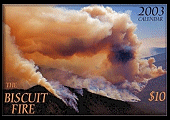




 "We live in the middle of the largest contiguous ponderosa pine forest on Earth," Howard said.
"We live in the middle of the largest contiguous ponderosa pine forest on Earth," Howard said.
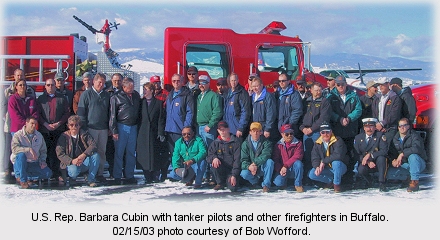
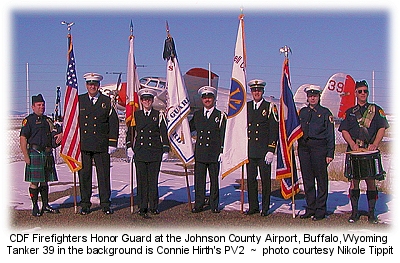
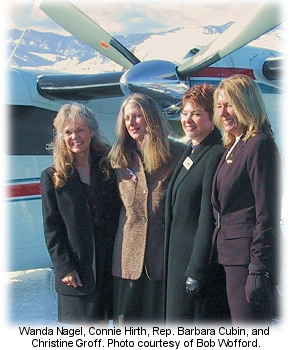 "Extending Public Safety Officers' Benefits to the families of tanker pilots and crews is the right thing to do."
"Extending Public Safety Officers' Benefits to the families of tanker pilots and crews is the right thing to do."
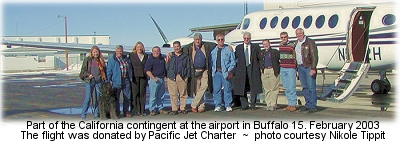 Dave Wardall is Deputy Chief for CDF in charge of aircraft maintenance and engineering. Wardall did a fine job of arranging for the trip to Buffalo by the CDF Firefighters Honor Guard. The flight from Sacramento, in a King Air 350 turboprop equipped with an AirShow 400 (which projects trip information overlaid on actual maps displayed on video monitors in the cabin), was generously donated by
Dave Wardall is Deputy Chief for CDF in charge of aircraft maintenance and engineering. Wardall did a fine job of arranging for the trip to Buffalo by the CDF Firefighters Honor Guard. The flight from Sacramento, in a King Air 350 turboprop equipped with an AirShow 400 (which projects trip information overlaid on actual maps displayed on video monitors in the cabin), was generously donated by  "These pilots and flight crews are basically on the front lines when it comes to fighting wildfires," added
"These pilots and flight crews are basically on the front lines when it comes to fighting wildfires," added 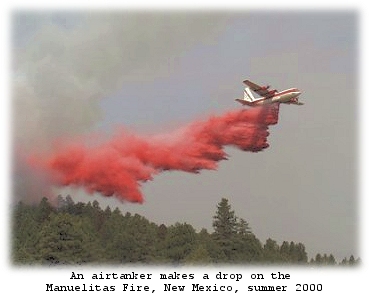 The Forest Service grounded all the federal large airtankers after a series of deadly crashes last fire season, and won't release them until they have been deemed safe by individual inspections. But according to
The Forest Service grounded all the federal large airtankers after a series of deadly crashes last fire season, and won't release them until they have been deemed safe by individual inspections. But according to 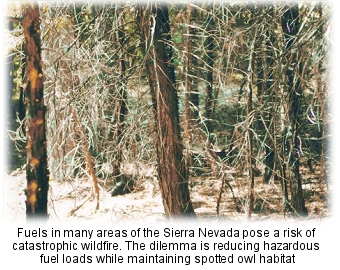 Blackwell says increased timber revenues will help foresters with fuels reductions; he says he's got "compelling evidence" that the original framework plans won't accomplish that goal. But environmentalists say he hasn't given the Sierra plan a chance to work.
Blackwell says increased timber revenues will help foresters with fuels reductions; he says he's got "compelling evidence" that the original framework plans won't accomplish that goal. But environmentalists say he hasn't given the Sierra plan a chance to work.
 The
The 